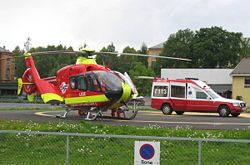Organization
Land ambulance
Land ambulance service provision is funded by the national government, and provided by means of one of the four Regional Health Authorities (Southern and Eastern Norway Regional Health Authority, Southern Norway Regional Health Authority, Western Norway Regional Health Authority, and Northern Norway Regional Health Authority) which provide most healthcare in Norway. Services may be provided directly by the Trust or its member hospitals, but are typically outsourced. [2] In many locations in Norway, the provision of land ambulance service is contracted to private operators, most typically large scale transportation companies operating a variety of types of service. Namsos Trafikkselskap (NTS) is an example of a private company participating in this type of arrangement for service delivery. While the majority of such arrangements are currently with Norwegian-based companies, this is changing, and international companies, such as Falck are beginning to contract for services in some areas. [3] Such services may operate 24 hours per day in larger centers, but in remote and rural locations are still frequently staffed by 'on-call' personnel after normal business hours. Even in areas with directly operated emergency ambulances, non-emergency transportation is more likely to be conducted by commercial transportation companies. Norway currently operates on the Franco-German model of EMS care, [4] with some limitations on the permitted skills of EMS personnel, and physician response to emergencies being quite commonplace.
- EMS Vehicles in Norway
- Mercedes-Benz Sprinter ambulance in service for Oslo and Akershus. The Sprinter is the most common type of ambulance in Norway.
- A former ambulance in the color scheme that existed until 2005
Air ambulance
As Norway has a very scattered population with many small towns and villages that are located far from hospitals and treatment centers, land ambulances are supplemented by both helicopters and fixed wing aircraft. These are organized nationally, under the title Norwegian Air Ambulance. Participants in the air ambulance scheme include the Royal Norwegian Air Force 330 Squadron, and also one privately owned company (Lufttransport) and one not-for-profit foundation (Norsk Luftambulanse). The relationship with the private company and the foundation are contractual, and currently extend to 2014. [5]
- Air ambulance in Norway
- Statens Luftambulanse (former name), operated by Norsk Luftambulanse, in old scheme
- Luftambulansetjenesten, operated by Norsk Luftambulanse, in new scheme
- A Westland Sea King helicopter operated by the 330 Squadron
- Air ambulance operated by Lufttransport
Marine ambulance
Norway's very nature and the fact that many communities are better accessed by water than by land have resulted in the use of dedicated, high speed water ambulances. [6] Such services may be provided directly, or may be contracted out to a larger marine transportation company. Water ambulances may be found in Oslo and Stavanger, among other locations.






